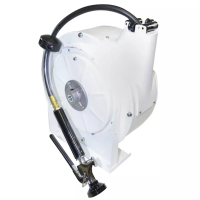Instruction Manual
D102005X012
846 Transducer
June 2017
23
The sensor's pressure signal is fed to a simple internal control circuit. By using this technique, the transducer's
performance is set by the sensor/circuit combination. Changes in output load (leaks), variations in supply pressure, or
even component wear are sensed and corrected by the sensor/circuit combination. Electronic feedback allows crisp
dynamic performance and readily compensates for output changes induced by vibration.
Note
Because the transducer is electronic in nature, it is not well‐modeled in the loop as a simple resistor in series with an inductor. It is
better thought of as a 50‐ohm resistor in series with a 6.0 V voltage drop, with negligible inductance.
This is important when calculating the loop load. When the transducer is used in series with a microprocessor‐based
transmitter, the noninductive nature of the transducer allows digital signals to successfully pass through undistorted.
Magnetic Actuator
The electronic circuit controls the level of current flowing through the actuator coil, which is located in the
pilot/actuator assembly. A change to the level of coil current is made by the electronic circuit when it senses a
discrepancy between the pressure measured by the sensor and the pressure required by the input signal.
The actuator performs the task of converting electrical energy (current) to motion. It uses a coaxial moving magnet
design optimized for efficient operation and is highly damped at its mechanical resonance. A silicone rubber
diaphragm helps to protects its working magnetic gaps from contamination.
Pilot Stage
The pilot stage contains two opposed fixed nozzles: the supply nozzle and the receiver nozzle. It also contains the
deflector, which is the moving element. See figures 11 and 12. The supply nozzle is connected to the supply air and
provides a high‐velocity air stream. The receiver nozzle captures the air stream and converts it back to pressure. The
receiver nozzle pressure is the output pressure of the pilot stage.
Figure 11. Deflector/Nozzle Pilot Stage Operation (Direct Action)
HIGH OUTPUT PRESSURE
PRESSURE TO
BOOSTER STAGE
REGULATED
AIR SUPPLY
LOW OUTPUT PRESSURE
DEFLECTED NOZZLE
FLOW PATTERN
PRESSURE TO
BOOSTER STAGE
REGULATED
AIR SUPPLY
A6645

